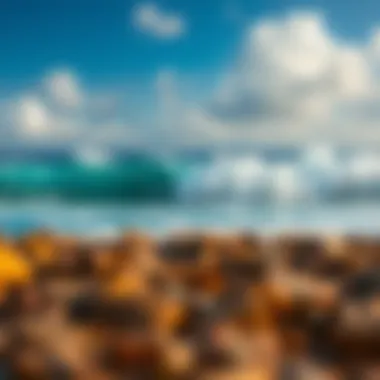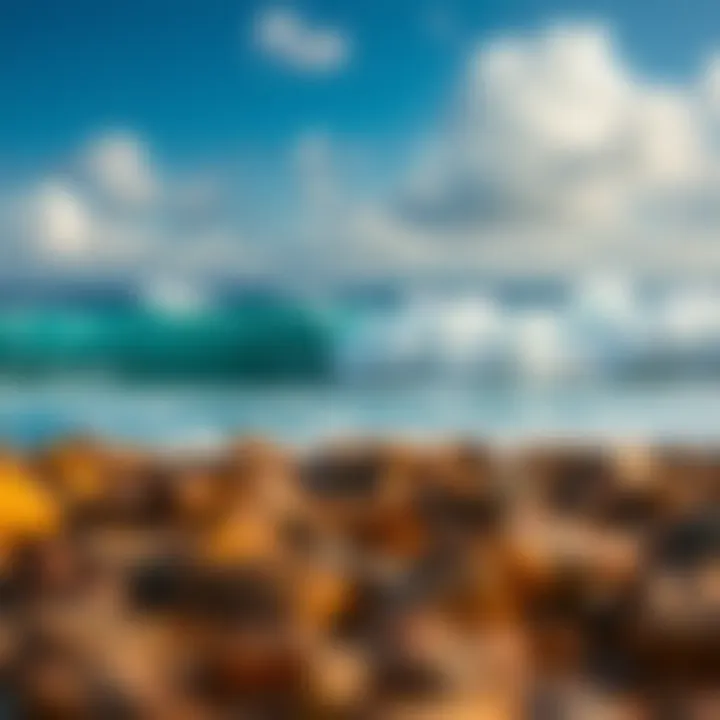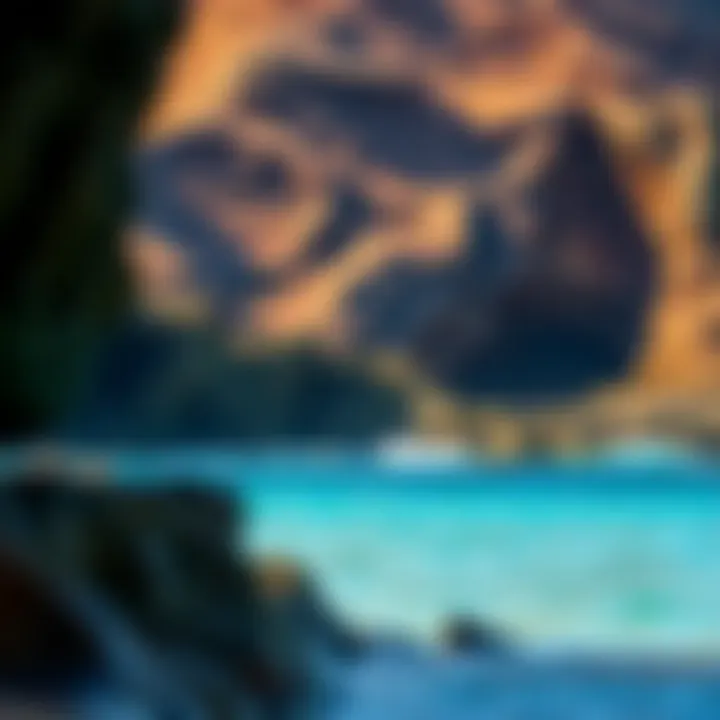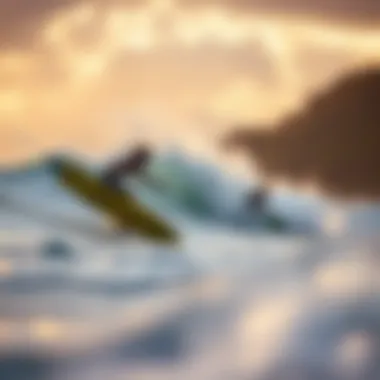Discovering the Allure of Ke Iki Beach on Oahu's North Shore


Intro
Located on Oahu's North Shore, Ke Iki Beach is a hidden gem that beckons surfers and nature enthusiasts alike. With its pristine sands and vibrant blue waters, it stands as a testament to the natural beauty of Hawaii. This beach serves not just as a spot for wave-riding but also as a space for personal reflection and appreciation for the ocean's grandeur. Whether you're carving up the waves or taking in the surrounding scenery, Ke Iki Beach leaves a lasting impression on all who visit.
The allure of this beach lies in its unique surf conditions, making it particularly inviting for those eager to challenge themselves on a board or simply connect with nature. But there's more than meets the eye here. The local culture, intertwined with the surf community, adds depth to the experience.
In this guide, we'll dive into some key themes that define Ke Iki Beach—ranging from the technological advances in surfboards to essential surfing techniques that cater to both novices and experts. Each aspect we explore is designed to enrich your understanding and foster a deeper appreciation for this extraordinary locale.
"Ke Iki Beach embodies not just the spirit of surfing, but also the essence of life on the North Shore. It's where the waves meet the lifestyle, creating a community bonded by water."
By the end of this article, you’ll have a well-rounded perspective of what makes Ke Iki Beach so special, whether you’re ready to hit the waves or just soak in the view.
Prelims to Ke Iki Beach
Ke Iki Beach is often regarded as a hidden gem along the North Shore of Oahu. This ordinary-sounding beach offers extraordinary gifts not just to surfers but to anyone who revels in nature's splendor. Located near the famous Waimea Bay, it survives in the shadow of its more famed neighbors, yet it retains an air of intimacy and charm. The sand shifts beneath your toes, while the sound of rolling waves reminds you of life's persistent rhythm. For both residents and visitors, Ke Iki embodies a communal spirit and serves as a testament to the advent of surf culture.
Location and Accessibility
Nestled between bustling beaches and scenic vistas, Ke Iki Beach finds its place as a serene escape from the North Shore's tourist hotspots. It lies about a 15-minute drive from Haleiwa town, accessible via Kamehameha Highway. The beach’s entrance can be a bit elusive, hidden among private properties, but once you find it, you’ll feel the ocean breeze beckoning.
Parking options are limited, primarily along the highway. It’s advisable to arrive early, especially during weekends when surfers flock to the waves. A large public parking lot is found at nearby neighborhoods, allowing for easier access if the road spots feel like a game of musical chairs. For those who prefer an eco-friendly touch, cycling from town or utilizing public buses adds a layer of adventure to the journey.
Historical Context
Ke Iki Beach is steeped in rich history and cultural significance for the Hawaiian people. Its name, translating to "the two rocks" in Hawaiian, suggests ancient stories of fishermen and ocean spirits who have roamed these shores long before contemporary tourism took root. In the past, the sandy stretch provided not just leisure but resources for communities. Surfing has long played a pivotal role in the lives of locals; it was not merely a sport but a revered practice connecting people to the ocean and to each other.
The evolution of surfing here echoes broader changes in world surf culture, from the wooden boards of yesteryear to modern shortboards today. As you walk along the beach, it’s hard not to feel the legacy of generations that have cherished this area. Local kanakas, or native Hawaiians, still hold onto traditional practices, securing a sense of identity and community against the backdrop of global surfing trends.
Understanding Ke Iki Beach's location and historical context allows visitors not just a spot to surf, but a deeper appreciation for the cultural tapestry that encompasses this beautiful landscape.
Geological Features
The geological features of Ke Iki Beach are not merely backdrops for a day of surfing. They play an essential part in defining the beach's character, influencing both the environment and the recreational activities available. A closer look into the sand composition and coral reef ecosystems unveils the underlying processes that shape this stunning location, making it not just a beautiful site, but a vibrant hub of biodiversity and natural intrigue.
Sand Composition
The sands of Ke Iki Beach are a tapestry of local geology. Composed primarily of finely ground coral and volcanic minerals, the beach’s sand is not just pleasant to step on; it also serves ecological functions. The high calcium carbonate content from eroded coral creates a soft, creamy texture that feels wonderful underfoot.
The unique aspects of the sand here are tied closely to both wave activity and wind patterns that shift and mold it over time. This constant movement contributes to the dynamic nature of the beach, providing diverse environments for nesting sea turtles and other wildlife that depend on the sandy shores.
- The color of the sand shifts between whitish to golden hues based on the time of day and sun’s position.
- Fine sands support a myriad of life forms, serving not only as a habitat but also assisting in filtering water and protecting marine ecosystems.
Tourists and locals alike often find themselves mesmerized by the vast stretches of sand, recognized for its warmth and calming influence. When visitors walk along this shoreline, they walk on layers of history, accumulated over thousands of years.
Coral Reefs and Biodiversity


Just beyond the gentle lull of the sand lies a vibrant underwater world that deserves a deserved spotlight. The coral reefs that surround Ke Iki Beach are more than just a colorful array of marine life; they are critical to the ecological balance of the area. These reefs act as barriers, reducing wave impact and protecting the beach itself from erosion.
The biodiversity in these waters is astounding:
- Fish Species: From the shy butterflyfish to the larger predator fish, this ecosystem harbors countless species that rely on the reef as a source of food and a breeding ground.
- Invertebrates: Sea stars, urchins, and various crustaceans contribute to the health of the coral, maintaining its integrity.
- Marine Plants: Algae and seagrass provide essential oxygen and habitat for various aquatic animals.
The importance of these coral systems extends beyond mere aesthetics. Numerous studies underscore the role of coral reefs in counteracting climate change, as they absorb significant amounts of carbon dioxide. Visitors at Ke Iki Beach not only experience a fantastic day of fun in the sun but also play a part in preserving an environment vital for future generations.
For anyone interested in marine biology, the reefs at Ke Iki Beach represent a live classroom, inviting exploration and learning.
Surf Conditions at Ke Iki
When it comes to surfing at Ke Iki Beach, understanding the surf conditions is crucial, not just for seasoned surfers but also for those who are keen on trying their hand at riding the waves. The surf conditions here set the stage for everything from casual frolicking to serious competitions, making it a significant aspect of the beach experience. The rhythm of the waves dictates not only the best times to surf but also speaks directly to the broader ecological dynamics at play, ensuring that surfers respect the ocean's power.
Seasonal Variations
Ke Iki Beach is quite a character when it comes to seasonal changes. Each season brings its own set of conditions, from mellow swells to fierce waves. Generally, the winter months, around November to March, showcase some of the most powerful surf, attracting experienced surfers from across the globe. During this time, the waves can easily reach heights that produce adrenaline-pumping rides. Conversely, the summer months, say June through August, often offer smaller, more manageable waves that are ideal for those just starting out.
- Winter: Big, challenging waves, thrilling for advanced surfers.
- Summer: Gentle waves suitable for beginners and families.
- Transitional Seasons: Spring and fall often feature in-between conditions, offering variety but can be unpredictable.
Wave Patterns and Stability
Understanding the wave patterns at Ke Iki is akin to deciphering a well-crafted piece of art. Swells rolling in can vary significantly based on wind direction, tide, and swell size. Local knowledge often highlights that the best waves typically break left, peeling slowly off the north to northeast swells. However, you might find the waves shift quickly after rain or strong winds change the atmosphere, making it essential for surfers to stay alert.
Additionally, stability is a key consideration. While Ke Iki has sections that offer reliable surf throughout the year, factors like seasonal storms can disrupt the consistency of the waves. Surfers must keep an eye on tide charts and recent forecasts to gauge when conditions are most favorable.
- Left-Hander Waves: Generally more abundant, allow for longer rides.
- Tide Influence: Medium to high tides are usually more favorable for optimal conditions.
- Wind Effects: Offshore winds can produce clean, glassy waves, perfect for a clear ride.
Ideal Conditions for Beginners and Pros
Ke Iki is not just a playground for veterans of the board. There’s room for everyone on its sands, provided you know when to visit. For beginners, the key is timing your visit during the summer months. During this time, the waves tend to be smaller, allowing novice surfers to practice with relatively less risk. Look for glimpses of surfers paddling out close to the shore, as this offers perfect example to mimic.
For seasoned surfers, winter is a peak time, but it comes with its set of challenges, including larger waves that require not just skill but a deep respect for safety.
- Beginners: Look for calmer, smaller waves and avoid peak surf times.
- Pros: Seek out the bigger swells and time your paddle-out with the tide cycles for maximum impact.
"It's not just about riding the waves; it's about harmonizing with the ocean's pulse. The true art of surfing lies in respecting the environment."
Navigating the surf conditions at Ke Iki demands adaptability and awareness. From understanding seasonal patterns to mastering the ocean's rhythm, the beach is a tapestry of experiences waiting to be explored. Whether you’re a first-timer or seasoned pro, the conditions at Ke Iki Beach promise a vibrant engagement with the waves that can pique any surf enthusiast's interest.
Local Culture and Community
When you set foot on Ke Iki Beach, you’re not just entering a spot for surf and sun; you’re stepping into a vibrant tapestry of local culture and community. This beach is a living reflection of the traditions, values, and daily lives of those who call the North Shore home. Understanding this aspect enhances your appreciation for the idyllic surroundings, turning a simple visit into an enriching experience.
Cultural Significance of Surfing
Surfing at Ke Iki Beach is more than just a sport; it is intertwined with the very identity of the community. The North Shore of Oahu has long been a crucible for surf culture, and Ke Iki stands as a testament to this legacy. Historically, surfing among Hawaiians was a rite of passage, a communal activity that strengthened bonds.


Today, that spirit persists. Local surf competitions are not just events but celebrations that draw together residents and visitors alike. The atmosphere during these events is electrifying, showcasing local talent while welcoming surfers from afar. Moreover, the indigenous surfing techniques and traditions, passed down through generations, come alive in the surf reports of the area. Commonly, surfers here engage in practices that demonstrate respect for the ocean and the legacy of those who surfed before them, such as understanding the wave patterns and ocean tides.
In the larger scheme, events like the Vans Triple Crown of Surfing provide locals with an opportunity to demonstrate their skills while asserting their cultural heritage.
Interactions with Local Residents
Meeting the folks from around Ke Iki Beach is like peeling back layers of history and community. The locals are warm, often eager to share stories about their lives and the beach itself. Coffee shops like the Tutu's Café, nestled nearby, are perfect spots to engage in casual conversation with friendly locals who will often recount tales of Ke Iki's waves and how they have shaped the neighborhood. You’ll also find experienced surfers willing to offer insights and tips to newcomers.
Furthermore, the relationship between locals and visitors is a crucial consideration. While there is openness to share the beauty of Ke Iki Beach, there’s a strong emphasis on respecting the local customs and the environment. Simple gestures, such as asking for permission before taking photos or being mindful of the beach’s cleanliness, go a long way in fostering good relations.
The community here has established postures of hospitality intertwined with stewardship. This reciprocal relationship not only enriches the experience for visitors but also upholds the cultural integrity of the area.
In summary, understanding the local culture and the community at Ke Iki Beach transforms one’s visit from a mere recreational outing to a meaningful journey. Engaging with the surf culture and resonating with the stories of the locals will make your time at this Hawaiian haven resonate well beyond the beach.
Safety and Regulations
When heading to the beach, especially a renowned surf spot like Ke Iki, the importance of safety and regulations cannot be overstated. With its powerful waves and dynamic conditions, being aware of certain safety protocols can make a significant difference. The safety guidelines not only protect visitors but also ensure that the natural environment remains preserved for future enjoyment. Key aspects to consider include lifeguard presence and the environmental regulations in place.
Lifeguard Presence and Emergency Services
Ke Iki Beach is monitored by lifeguards who keep a watchful eye on the surf conditions and beachgoers. This presence provides a sense of security, especially for families and those less experienced with ocean activities. Lifeguards are trained not just for rescue operations, but also for first aid and emergency response, meaning that visitors can feel more at ease enjoying the waves knowing help is readily available.
It's vital to note their positioning on the beach; lifeguard towers are marked clearly, so make sure to stay close by them when swimming or surfing. If ever caught in a tricky situation — whether it's a strong current or a fall — signal directly to a lifeguard or use the universally recognized wavy hand signal. Lifeguards are particularly adept at assessing the risks posed by changing tide conditions, advising visitors when it’s best to stay out of the water to prevent injury.
For anyone planning to surf at Ke Iki, keeping tabs on the daily briefings by the lifeguards can prove beneficial. They’ll often fill you in on any hazards such as riptides, unusual marine life sightings, or even the best practice techniques that can help you stay safe while enjoying the surf.
Environmental Regulations and Preservation Efforts
Ke Iki Beach is not just a playground for surfers and beach lovers; it is also an ecosystem that requires respect and care. Environmental regulations established by local governing bodies help protect the beach’s natural beauty and the delicate marine life that resides there. These regulations often include restrictions on specific activities that could harm the local wildlife or degrade the beach environment.
Visitors should adhere to the rules against littering — bringing trash back home or using designated disposal areas is paramount. This practice not only ensures the beach remains pristine for others but also protects the numerous species that call this coastal area home. Coral reefs, for example, are particularly sensitive to pollution and physical damage, so be mindful while participating in activities like snorkeling or surfing to keep your distance from them.
Another significant aspect of these regulations revolves around sustainable practices. Many local organizations, such as the Department of Land and Natural Resources, promote educational programs that inform visitors about the importance of preserving the beach's ecosystems. Engaging with these initiatives can deepen one’s appreciation for Ke Iki, transforming a casual visit into a more enriching experience.
The preservation of Ke Iki Beach symbolizes the broader environmental consciousness that surf communities are increasingly adopting across the globe. With tides changing, so too must our approach to enjoying and maintaining the natural beauty we cherish.
Visitor Information
Visitor Information is an essential aspect of understanding Ke Iki Beach. This section brings to light the vital details every traveler should know before embarking on a journey to this stunning coastal destination. With its unique surf conditions and rich cultural tapestry, knowing when to visit, what facilities are available, and nearby accommodations can make or break any beach trip. Travelers, surf enthusiasts, and those simply curious about nature can all benefit from this thorough guide.
Best Times to Visit
When planning a trip to Ke Iki Beach, timing is everything. While Oahu enjoys a warm tropical climate year-round, certain months present more favorable conditions for various activities. Surfers eager to catch those perfect waves might prefer the winter months, from November to March, when the North Shore experiences the largest swells. However, visiting during the summer, particularly from April to October, can provide calmer waters, perfect for beginners and casual swimmers.
"Timing your visit to Ke Iki can enhance your experience immensely!"
Considering weather patterns and the general tourist flow is also important. Weekdays tend to be less crowded compared to weekends. Early mornings or late afternoons often offer not just better surf but also breathtaking sunsets that make for perfect photo ops. It's wise to check local surf reports and forecasts ahead of time, ensuring you pick a day that aligns with both your surfing ambitions and sightseeing plans.


Access to Amenities and Facilities
Convenience is something all visitors appreciate, especially at a beach like Ke Iki. While it may not offer the bustling amenities found at more commercial beaches, it does provide essential facilities that enhance the visitor experience. There are public restrooms and outdoor showers available, allowing for a quick rinse after a long day in the surf.
Food trucks and small local shops often pop up nearby, serving an array of local favorites like poke bowls and shave ice, so visitors can savor the local palate. It's also worth mentioning that parking can be limited, especially on weekends, so arriving early might just save you from the hassle of searching for a spot.
Accommodations Nearby
Finding a place to lay your head after a day on the beach is crucial. Many options are within a reasonable distance from Ke Iki Beach, catering to a variety of preferences and budgets. For those who love the sound of the surf lulling you to sleep, beachfront rentals offer an incredible getaway. Locations like the Turtle Bay Resort boast luxurious amenities with direct beach access.
For travelers on a tighter budget, nearby hostels and vacation rentals provide cozy alternatives that allow for more interaction with fellow beachgoers. A quick check on platforms like Airbnb or booking.com can yield numerous choices, tailored to solo adventurers, couples, or families. Whether you opt for a rustic charm or a resort experience, it’s easy to find your niche near Ke Iki, facilitating a memorable stay.
Environmental Considerations
Exploring Ke Iki Beach goes beyond just enjoying the sun and surf. It also brings to light the pressing environmental considerations associated with tourism and recreational activities. As visitors flock to this serene spot on Oahu’s North Shore, it is crucial to recognize the impact their presence has on the delicate ecosystem.
Impact of Tourism on Ecosystems
The popularity of Ke Iki Beach has its pitfalls. Increased foot traffic can lead to coastal erosion, which diminishes the beach's natural beauty and affects marine life. Think of it like this: when too many people trample the same patch of grass, it gets compacted and struggles to grow back. Likewise, the sandy beaches face a similar fate.
- Coral Reefs at Risk: The beach is home to adjacent coral reefs that provide habitat for diverse marine species. As snorkelers and divers explore these vibrant underwater gardens, careless actions can damage or destroy these fragile ecosystems.
- Wildlife Disturbance: The nesting habits of sea turtles and shorebirds are compromised by the presence of humans. Their natural behaviors are interrupted when too close to the shore, leading to a decline in local populations.
Despite tourism's economic benefits to local communities, balancing visitor enjoyment with conservation efforts is vital. Education about local wildlife and potential hazards of disturbing nesting sites is paramount to preserving the beach's ecosystem for future generations.
Sustainable Practices for Visitors
Understanding the significance of preserving Ke Iki Beach necessitates adopting sustainable practices as visitors. Making small changes can collectively have a big impact. Here are some actionable suggestions for anyone looking to enjoy this beautiful beach responsibly:
- Leave No Trace: Always clean up after yourself. Take all trash, including food wrappers and plastic bottles, back with you. Keeping the beach clean ensures wildlife isn't harmed by ingestion or entanglement.
- Respect Designated Areas: Stay within marked paths to reduce ecological disturbance on grasslands and dunes where native plants grow. These plants are essential for preventing erosion and providing habitats for other species.
- Mind the Wildlife: Keep a respectful distance from nesting sites of sea turtles and birds. If you see a nest, avoid the area as much as possible.
- Use Reef-Safe Products: When swimming or snorkeling, employing reef-safe sunscreen helps protect coral from harmful chemicals.
"Protecting the beach isn’t just about preserving a location; it’s about ensuring that the beauty and life of Ke Iki continues to thrive for those who come after us."
In summary, visitors to Ke Iki Beach should strive to minimize their environmental impact while maximizing their enjoyment. By following these principles, you contribute to maintaining the beach's natural beauty and ecological integrity. Keeping Ke Iki Beach pristine benefits not only the immediate ecology of Oahu but also enriches the experience for everyone who comes to appreciate its breathtaking landscape.
Ending
The conclusion of this exploration into Ke Iki Beach does more than just summarize key points; it serves as a reflective pause for visitors and surfing enthusiasts alike to consider what this beach represents within the realm of surf culture and environmental mindfulness.
Reflections on Ke Iki Beach
Ke Iki Beach is not just another spot on a map; it embodies the spirit of Oahu's North Shore—a place where the ocean meets the sky and the rhythm of the waves resonates like a heartbeat. As surfers, beachgoers, or even those just looking to bask in tranquility, one can often find a deeper connection to nature and oneself in the gentle ebb and flow of the tide.
The shimmering sands and rolling waves tell stories that echo throughout time, revealing the rich local culture that surrounds it. The beach captivates with its beauty, but it also serves as a reminder of the delicate balance we must maintain with our natural environments. This perpetual dance of surfing enthusiasts and the enchanting allure of the Pacific fosters a unique community where shared experiences occur daily. Additionally, the mix of vibrant local culture and the ever-changing surf conditions invites reflection on how much this beach has transformed over the years, from a hidden gem to a popular surfing destination.
Future Perspectives for Surfing Communities
Looking towards the future, surfing communities, particularly around Ke Iki Beach, face challenges and opportunities. As the popularity of the beach grows, so does the need for community-driven conservation efforts. The participation of surfers in environmental initiatives ensures that the natural beauty and integrity of the beach endure for generations to come. This is crucial as climate change poses threats to coastal areas, and rising water temperatures put marine life at risk.
Engagement in educational programs that emphasize sustainable tourism can enhance visitors’ awareness and encourage eco-friendly practices.
- Strengthening local partnerships: Local surf schools and organizations could play a pivotal role in fostering community spirit through educational workshops and beach clean-ups.
- Innovative practices: Utilizing technology to create an app that promotes surf and environmental safety could significantly enhance the experience while protecting the beach.
- Sustaining the culture: Encouraging local artisans and surf-related businesses can help keep the culture alive while promoting economic opportunities.
Through collaborative efforts, we can ensure that Ke Iki Beach remains a thriving hub for surfers, a sanctuary for marine life, and a wonderful escape for future generations. The future holds promise, but only if current and future surfers commit to protecting the beauty and health of the beach.



